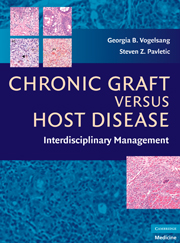Book contents
- Frontmatter
- Contents
- List of Contributors
- Preface
- PART I GENERAL PRINCIPLES
- 1 Historical Aspects of Chronic Graft versus Host Disease
- 2 The Pathophysiology of Acute Graft versus Host Disease
- 3 Pathophysiology of Chronic Graft versus Host Disease
- 4 Animal Models of Chronic Graft versus Host Disease
- 5 Incidence and Trends
- 6 Clinical Manifestations and Natural History
- 7 Risk Factors and Predictive Models for Chronic Graft versus Host Disease
- 8 Biomarkers in Chronic Graft versus Host Disease
- PART II CLINICAL MANAGEMENT
- PART III ORGAN SITE OR SYSTEM-SPECIFIC MANIFESTATIONS
- PART IV SPECIAL CONSIDERATIONS IN CHRONIC GVHD
- Index
- Plate section
8 - Biomarkers in Chronic Graft versus Host Disease
from PART I - GENERAL PRINCIPLES
Published online by Cambridge University Press: 26 August 2009
- Frontmatter
- Contents
- List of Contributors
- Preface
- PART I GENERAL PRINCIPLES
- 1 Historical Aspects of Chronic Graft versus Host Disease
- 2 The Pathophysiology of Acute Graft versus Host Disease
- 3 Pathophysiology of Chronic Graft versus Host Disease
- 4 Animal Models of Chronic Graft versus Host Disease
- 5 Incidence and Trends
- 6 Clinical Manifestations and Natural History
- 7 Risk Factors and Predictive Models for Chronic Graft versus Host Disease
- 8 Biomarkers in Chronic Graft versus Host Disease
- PART II CLINICAL MANAGEMENT
- PART III ORGAN SITE OR SYSTEM-SPECIFIC MANIFESTATIONS
- PART IV SPECIAL CONSIDERATIONS IN CHRONIC GVHD
- Index
- Plate section
Summary
INTRODUCTION
Graft versus host disease (GVHD) is one of the most important and potentially fatal complications of hematopoietic stem cell transplantation (HSCT). In its acute form, it can occur in 30% to 50% of patients transplanted with either a human leukocyte antigen (HLA)-matched sibling donor or matched unrelated donor, and the incidence of chronic GVHD (cGVHD) is increasing even further, affecting 40% to 70% of patients. A degree of acute GVHD (aGVHD), however, in the less severe form, grade I to II, may be beneficial and enable a graft versus leukemia (GVL) effect aiding in the destruction of residual leukemic cells. Similar to moderate aGVHD, cGVHD has been shown to be associated with a reduced relapse rate. There is a fine balance therefore between a detrimental GVHD and a beneficial GVL effect. The ability to predict GVHD and its severity or the response to therapeutic strategies would therefore enable the clinician to tailor therapy on an individual basis to improve outcome. Considering the morbidity associated with prolonged and extensive cGVHD, availability of biomarkers should improve the quality of life of patients and ultimately reduce health care costs.
The types of biomarkers for either predicting or monitoring cGVHD include the use of serum cytokines and markers indicating inflammation including cellular assays, lymphocyte subset analyses, and the use of non-HLA genotypes. Recent use and further research into the use of proteomics for predicting both GVHD and developing new biomarkers has also been described.
- Type
- Chapter
- Information
- Chronic Graft Versus Host DiseaseInterdisciplinary Management, pp. 79 - 84Publisher: Cambridge University PressPrint publication year: 2009



